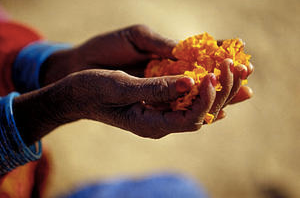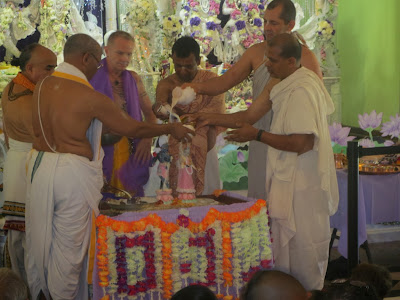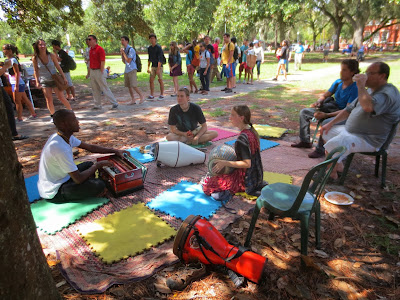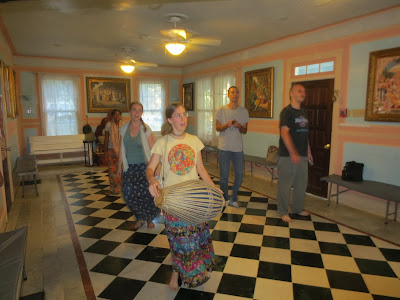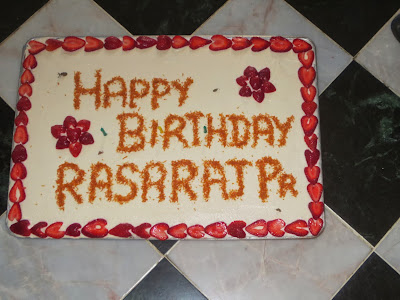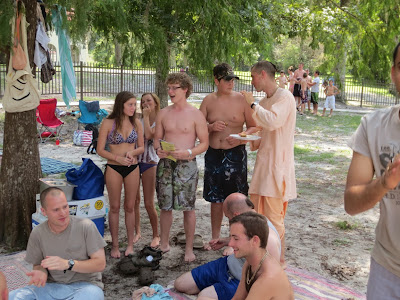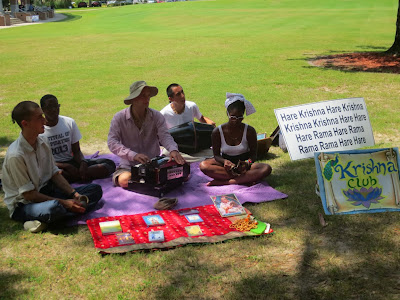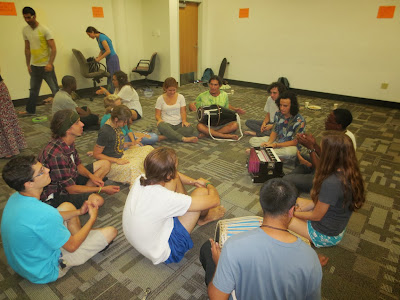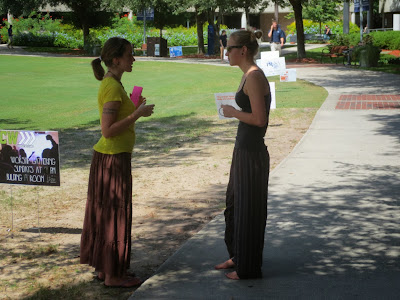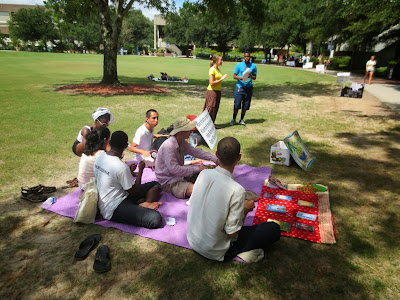Janmastami 2013 Kirtan – ISKCON Brisbane
Janmastami 2013 Kirtan – ISKCON Brisbane
Wednesday, September 25th, 2013
→ The Walking Monk
Toronto, Ontario
It was a small chanting party that enthused the public at the business and shopping area of Bay and Bloor. We were a lively bunch. We looked happy. One of our monks from the ashram, Maha Mantra by name, is particularly good at playing the mridanga drum. Pedestrians would light up when passing our jolly crew, although you could see the occasional nose in the air kind of response.
One particular fellow took us by surprise. He was obviously drunk. At the same time, he would not be in the category of being a total loser. He was dressed very spiffily even.
“Sixty-nine!” he slurred, “It was Sixty-nine I first met you guys at Rochedale.” Rochedale was an experimental cooperative high rise where you found intellectuals, hippies, beatniks and even Hare Krishnas who are living on one floor. At that time there was rampant drug usage, sex orgies, people jumping out the windows while tripping. Of course, the Krishna’s were exempt from those habits. It was cheaper accommodation so they found it favourable for residing there.
In any event the elated chap kept talking, embracing, and handing us cash, even though we never asked for any. It was hard to comprehend what he was saying at times, he just kept rattling on as we enjoyed his spontaneously warm reception. He kind of made our day you could say by the way that he was so overly accepting of us. At least we could decipher when he said, “Group hug, group hug,” to which we responded. Indeed he was the strongest character we met of all the people there, and he left an impression.
Now, if someone asks why are we out here in the first place, singing and playing all this music, how to respond? Are we a band of street musicians out here to entertain?
The answer to this type of question actually surfaced in our morning discussion when we explored what sacred space is. The sage, Narada Muni defined pilgrimage space in the book Bhagavatam as an area where spiritual activity is enacted.
For those of us who processioned our way from our ashram to Bloor Street, we no doubt benefitted from the workout, and especially for Dharma, a monk in his 60’s who has some disability. We feel that chanting in various public locations offers the space a transition of spirit. It is meant to be an act of magnanimity that great kirtan yogis have made as a contribution to the world.
9 KM
Tuesday, September 24th, 2013
→ The Walking Monk
Brampton, Ontario
When I trek through the villages of the prairies just on this last ventures, I sought to meet people. And, for the sake of replenishing energy, I also kept my eyes on the trees of the village in hope to at least spot an apple tree. It’s that time of year that this hearty fruit comes up for harvest. A lesson on detachment often came my way because trees for wind and snow shelter is common around at a person’s house. But that’s the prairies, you’re lucky to find apples.
Now that I’ve arrived in a quite different environment, vegetationally and perhaps culturally also, farmer’s apple trees planted from the days of yore were in the plenty in the Heart Lake area of Brampton. There were multiple varieties. Rajnish, Alpa and I took to the edge of the lake for a stroll only to be richly rewarded with these fleshy and tasty packages of mercy.
Things looked up throughout the day. I signed papers for a 2 year lease to a building, the new location of our Brampton community for future occupancy right in the downtown core. This is a victory of course.
I also could not help to sense another stroke of optimism in the air when later on in the day I veered to the quite Rosedale neighbourhood on a second solo walk near downtown Toronto. In front of me a young man was singing a song to himself as he was striding several metres ahead of me. I first heard him as we ambled on a bridge overlooking the ravine. I admit I was drawn to the song, but I couldn’t discern the genre of music. Then I concluded that it was like a lullaby, it was that mystical time of day at dusk. And as I picked up speed with the anticipation of hearing more clearly, it seemed that he did also. He was dark, either black or east Indian, he kept going on at it until he made a turn. By then the sun had almost vanished, so I lost him. It’s rare to hear someone sing to themselves for a prolonged time. It was like a discovery moment. A discovery which excites like coming upon an abandoned apple tree at Heart Lake.
I had turned a corner myself, making my way back to the ashram. I greeted a guy and said, “How are you?” His tone was terrible, in fact he blurted out the word, “Terrible.”
“What’s wrong?” I stopped and asked, “Such extremes,” I thought. I jumped from Mr. Happy Go Lucky to Mr. Grumps.
Mr. Grumps was beefing about clearing someone’s yard of unwanted shrubs and how he didn’t get paid. I tried to cheer him up, but it appeared that the chip on his shoulder was a heavy chunk.
I hope he finds his apple tree.
9 KM
Monday, September 23rd, 2013
→ The Walking Monk
Edmonton, Alberta
Yogendra, an active member of the Radha Govinda Cultural Centre, helped break the 0KMs/miles of yesterday. It seems tragic when you don’t score in one day. Realistically, the rest is necessary.
In the Rutherford region of Edmonton, a suburban trail did suffice. It took us by surprise, but there it was, just as we were headed by vehicle to a known spot we stumbled upon a forested trail. I’m grateful that urban planners include paths for people. Our grand score was a whopping 3 KMs, sarcastic as it may sound.
Feet do make noise when they move. Creatures that reside on either side of the trail can hear steps and/or feel the vibes that we create. In the course of this puny trek, I observed a haunting quiet. It’s obvious we’ve entered the fall season and that means longer sleep for many living entities, and a deeper receding in to holes and crevices and the earth and the trees. Mosquitos or bugs are now retired for a while, something I don’t necessarily lament over. But, whatever the season, we humans manage to routinely blaze the same trail. We are out and about. I guess that you could say that we are the resilient bugs.
Sharada conducts a Krishna Sunday school in her own home. Her husband, Srinivasan, is most supportive of the program. Together they hosted a satsang, a spiritual gathering. It was Daruka and I in this last night out together who shared with this group our reminiscences of our trekking adventures. It was a sometimes crazy adventure that we had. Kirtan calmly closed the session, as did a great veggie feast. I rounded up the event with a reading from the book Bhagavatam, 1.11.26, it was a description of Bhagavan.
“His chest is the abode of the goddess of fortune. His moonlight face is the drinking vessel for eyes which hanker after all that is beautiful. His arms are the resting places for all the demigods, and His lotus feet are refuge of pure devotees who never talk or sing of anything not in relation to Him.”
Thanks, Daruka, for a fine journey with you and Billy. Until we resume in the spring – Hare Krishna.
3 KM
dig deep
→ everyday gita
When reading this verse today, my attention was captured by the word "offer".
In one sense, the whole world revolves around offerings. Whether working or in school, we are constantly "putting forth something for consideration or acceptance". When we are applying for a job, we are offering our services and intelligence to work. When we enter into and maintain relationships, we offer our heart and emotions.
In fact, one could say that every minute of every day is filled with offerings.
After all, it is one of the main functions of the mind. The mind is constantly putting forth ideas and thoughts as to how we can increase our happiness and minimize distress.
But the mind's offerings are often limited. Unless exposed to the culture of gratitude and selflessness, it can be difficult to comprehend the concept of "offering one's life in service." And that, ultimately, is what yoga is all about.
For some, including myself, contemplation of this "career path" can bring up a lot of insecurities and revelations as to where we place our faith and trust. Offering one's life in service, from the yoga perspective, is not just dedicating oneself to a job. It's about utilizing this life to realize who we really are and why we are here. That is - realizing that we are spiritual beings having a material experience.
It requires deep introspection and a willingness to confront our frailties. It takes courage, proper guidance and support to realize that we are not in this world just to enjoy it but to learn from it. By being able to see the lessons that are ever present in all opportunities and experiences that we undergo, we start to learn that there is more to life than just satisfying the senses. It is then that the desire to go deeper burns stronger and we in turn can really start tuning into who we really are through the wisdom of great texts such as the Bhagavad gita. That knowledge, when realized, allows us to become empowered instruments to help others and affect positive change in this world.
But that first step requires a leap of faith to dig deep. Are you ready?
A message of love
→ KKS Blog
(Kadamba Kanana Swami, 20 March 2013, Cape Town, South Africa, BTS Vyasa Puja Talk)
 Bhakti Tirtha Swami showed the message of love at the end because in the process of leaving this world, he did not make that just a private affair. He did not just turn away from the world in a mood of, “Well, now I have to go. Bye. Bye.” No! In an intense way, he really connected with everyone, especially his disciples, and also so many others. Whoever was ready, he would give them so much energy, that he was actually comforting people; he was inspiring them. He was giving instead of taking some support; instead of waiting for the sympathy of the visitors to sort of cheer him up in the midst of the misery of dying!
Bhakti Tirtha Swami showed the message of love at the end because in the process of leaving this world, he did not make that just a private affair. He did not just turn away from the world in a mood of, “Well, now I have to go. Bye. Bye.” No! In an intense way, he really connected with everyone, especially his disciples, and also so many others. Whoever was ready, he would give them so much energy, that he was actually comforting people; he was inspiring them. He was giving instead of taking some support; instead of waiting for the sympathy of the visitors to sort of cheer him up in the midst of the misery of dying!
He was the one who gave everyone fresh energy, fresh inspiration with whomever he dealt with. And he just grew that to a proportion of spiritual depth and ecstasy that it was extraordinary. He was beaming. He was just full of effulgence at that time and one could see. You know, in America, they say “Put your money where your mouth is,” and he did it. He showed us. He spoke all these years of love and love and love… and then at the end, he really showed that he had it, that it wasn’t just a speech but that he had that love in his heart, and he gave it to everyone!
What the Gita is meant to show
→ The Spiritual Scientist
The Bhagavad-gita is meant to show how one can understand his spiritual existence and his eternal relationship with the supreme spiritual personality and to teach one how to go back home, back to Godhead.
SB 5.11.13 – The Lord is transcendental and self-revelatory – beg for his mercy by consistent meditation
→ The Spiritual Scientist
18.71 – The words will change us – provided we don’t change the words
→ The Spiritual Scientist
When a doctor writes a prescription, those words are meant to change the patient by curing the disease. But if the patient changes the words of the prescription as per one’s own convenience, then they lose the power to heal.
The Bhagavad-gita’s words are like a doctor’s prescription. They can cure the disease afflicting our heart – the disease of misdirected desires, wherein we love temporary worldly things instead of the eternal Lord of our heart, Krishna.
The Gita’s words are not just the prescription but also a part of the medicine. Hearing the message of Krishna is itself a central limb of devotional service, the process that cures our heart disease. The Bhagavad-gita (18.71) indicates that those who hear the Gita faithfully become purified and elevated.
How does this happen?
The Gita’s words reveal Krishna’s unfailing, unflinching love for us. If we hear those words faithfully, we naturally feel attracted to reciprocate love with the Lord who loves us so much.
Hearing faithfully doesn’t mean that we accept unquestioningly, but that we consider open-mindedly. Open-minded consideration implies readiness to be patient and persistent – as we are when we study, say, a scientific subject. If understanding an aspect of existence, as is studied by science, requires patience and persistence, then won’t understanding the source of existence require similar, if not greater, endeavor? Logically it will.
Unfortunately, some people who don’t want to endeavor thus change those words of the Gita that don’t make sense to them. For example, failing to understand how Krishna is the transcendental Supreme Person, they reduce him to a metaphor – and thereby deprive themselves of his love.
If we resist this temptation to take intellectual shortcuts, the Gita’s words of love will take us smoothly on the devotional expressway towards Krishna.
***
18.71 - And one who listens with faith and without envy becomes free from sinful reactions and attains to the auspicious planets where the pious dwell.
Become the example others want to follow
→ simple thoughts
I received a wonderful e-mail this week it was very encouraging to see the progress of a young devotee as they progress in devotional life; for me it shows that example and association is more important than classroom teachings.
It also reminded me of responsibility as an initiated devotee, my example can either encourage and inspire others of hinder their spiritual progress. If I am for real in pursuing the request from my guru maharaja to distribute Srila Prabhupada’s books and to share love of Krishna then this comes out in how we speak and act.
The devotee although busy in studies is inspired to distribute Srila Prabhupada’s books and to share love of krishna with others; indeed as I listen to them their conversation is becoming sweeter and sweeter as they speak more about krishna.
Example speaks more than words, listening and questioning means we gain a greater understanding it takes time indeed Srila Prabhupada always talked about how much it takes to make just one devotee. So taking time is more important than directing to a course.
This for me shows that what we describe as mentor-ship is valuable, this should mean we take the personal time to get to know the individual yes association this gives the person the opportunity to ask questions they may feel uncomfortable to ask knowing they can trust and gain the right answer.
It gives us the chance to know the person, their strengths and weaknesses allowing us to tailor and help them progress slowly but surely; we should realize that this is a life time relationship. Indeed we see that those who have been and remained in Krishna Consciousness for a long time have beep friendships that they have encouraged each other through hard times and inspired each other.
So reading the e-mail I smiled the individual that contacted me all that time ago has surpassed me in realizations and desire to share with others; it is amazing to see and also humbling as they thanked me for being the example for them to follow now I think they are giving me the example to follow.
And this for me is the final key to mentor-ship friendship we both become inspirational to each other, this inspiration means we both become stronger in devotional life; this cannot be replicated in a classroom.
And Yes this for me means we have to be clear in our own Krishna Consciousness and make sure we ourselves present it accurately, for conversely if we are always finding or presenting the things we see as wrong within the devotee society then this rubs off and they too reflect this negativity.
The end thoughts is that the main thing is that we understand and follow instruction so that our actions become the example; our example then means we become the inspiration for others; they become inspired and become the inspiration for others and thus the society grows richer and stronger.
HG Deva Darsana Prabhu / BG 9: The Most Confidential Knowledge
→ Kalachandji's Audio Archive
HH Giriraj Swami / SB 1.2.17
→ Kalachandji's Audio Archive
Secret
→ Seed of Devotion
I'll tell you a secret: I have absolutely no idea what is going on in my life.
Maybe I seem like I have it all together; my career, family life, spiritual life. All my life I've been a "conviction" type of girl - deciding on a path and walking that path with one-pointed zeal.
But now?
Not really.
If you could peek inside my mind, you'd find a whirling tornado like in the Wizard of Oz, with houses, bicycles and people flying through the air. For the past nine months or so, half-baked plans and half-hearted convictions whirl through my mind and make me dizzy. And sad.
And lost.
All I can do is put one foot in front of the other - offer worship to Radha Murlidhar, go to work, host a program, engage in this beautiful adventure of living at the Bhakti Center. Just keep going. But when I look up - what's your plan for your career, Bhakti? what's your plan for college, Bhakti? what's your plan for making money, Bhakti? what's your plan for community, Bhakti? what's your plan for service, Bhakti?
I don't know I don't know I don't know.
I don't know.
So there you are, that's my secret.
What's yours? Ha ha!!
Prasadam distribution at MAHESH GANJ 26/09/2013 (84 photos)
→ Dandavats.com
 The spiritual master encourages distribution of prasadam (remnants of Krsna's food) to the public. Ours is not a dry philosophy--simply talk and go away. No. We distribute prasadam, very sumptuous prasadam. In every temple, we offer prasadam to anyone who comes Read more ›
The spiritual master encourages distribution of prasadam (remnants of Krsna's food) to the public. Ours is not a dry philosophy--simply talk and go away. No. We distribute prasadam, very sumptuous prasadam. In every temple, we offer prasadam to anyone who comes Read more › Loving Exchanges
→ travelingmonk.com
Recipe for the Suffering Soul
→ Dandavats.com
 My Initiated name is Candra Das. I am a disciple of H.H Bhakti Tirtha Swami Maharaja. I am currently employed as a correctional counselor at Snake River Correctional Institution in Ontario, Oregon (Snake River Correctional Institution is located 11 miles east of the Idaho/Oregon state line). I have been employed with the Oregon Department of Corrections for 18 years Read more ›
My Initiated name is Candra Das. I am a disciple of H.H Bhakti Tirtha Swami Maharaja. I am currently employed as a correctional counselor at Snake River Correctional Institution in Ontario, Oregon (Snake River Correctional Institution is located 11 miles east of the Idaho/Oregon state line). I have been employed with the Oregon Department of Corrections for 18 years Read more › World Holy Name Week 2013 Denpasar, Bali, indonesia (131 photos)
→ Dandavats.com
 The chanting of the Holy Names is the most auspicous practice in the universe. Therefore to achieve auspiciousness, especially in Kali Yuga, one must engage in Sankirtan. Intellegent people will adopt this process.
Read more ›
The chanting of the Holy Names is the most auspicous practice in the universe. Therefore to achieve auspiciousness, especially in Kali Yuga, one must engage in Sankirtan. Intellegent people will adopt this process.
Read more › September 26th, 2013 – Darshan
→ Mayapur.com
The post September 26th, 2013 – Darshan appeared first on Mayapur.com.
Vowing like Ajamila to fully control ourselves, always engage in devotion and thus avoid falling into darkness again
→ SivaramaSwami.com
Sadhu Sanga Festival on the Black Sea in Russia (17 photos)
→ Dandavats.com
 Indradyumna Swami: Through kirtan, Krsna katha and prasadam thousands of devotees are exchanging their loving sentiments at the Sadhu Sanga Festival on the Black Sea in Russia. Read more ›
Indradyumna Swami: Through kirtan, Krsna katha and prasadam thousands of devotees are exchanging their loving sentiments at the Sadhu Sanga Festival on the Black Sea in Russia. Read more › Sri Sri Krishna Balaram Mandir Kartika Parikrama Schedule
→ Dandavats.com
 Kartika is glorified in the Puranas as very special for making spiritual advancement and the best place to be in Kartika is Sri Braja Dham. In fact this month is known as Damodar, since in the middle of this month, the Lord performed His very enchanting Damodar Lila. Kartika month also represents Radharani, and devotees perform special austerities to gain Her favor Read more ›
Kartika is glorified in the Puranas as very special for making spiritual advancement and the best place to be in Kartika is Sri Braja Dham. In fact this month is known as Damodar, since in the middle of this month, the Lord performed His very enchanting Damodar Lila. Kartika month also represents Radharani, and devotees perform special austerities to gain Her favor Read more › ISKCON New Vrindaban Board Meeting Minutes – 9/11/13
→ New Vrindaban Brijabasi Spirit
ISKCON New Vrindaban Board Meeting Minutes – 9/11/13
Vision Statement: Founded in 1968, Srila Prabhupada boldly envisions New Vrindaban as a sacred place known worldwide for Cow Protection, Self-Sufficiency, Holy Pilgrimage, Spiritual Education, and, above all, Loving Krishna.
Present: Jaya Krsna, Jamuna, Gopisa, Dayavira, Chaitanya Mangala & Ranaka.
Recording Secretary: Laxmi Honest
Gopisa reported on the utility building. The project is moving forward with Moses and Dev Kumara agreeing to close it in. The replacement of the roof would cost $60,000 plus, and that is beyond the available budget. Dayavira suggested that we use the $5,000 budget to patch it up and put it on hold. The subject will be brought up again at the next joint board meeting.
Gopisa gave an update on the Palace Stairs restoration. Soma has agreed to do the stone setting work. We need to write up a contract and order the granite. There is a budget of $100,000 which Gopisa believes should be sufficient to purchase all the granite for the upper and bottom steps, repair the upper steps and put a roof on the old ghee factory (which will be used as work space during renovations).
Ranaka brought up annual funding for Gopal’s Garden School. INV will determine the source of the funds for the academic year’s support at the next meeting.
HH Bhakti Caru Swami, Srila Bhaktivinoda Thakura & Srila Gadadhara Pandit Disappearance Day
→ Gouranga TV - The Hare Krishna video collection
HH Bhakti Caru Swami, Srila Bhaktivinoda Thakura & Srila Gadadhara Pandit Disappearance Day
Travel Journal#9.17: Dublin, Philly, and North Florida
→ Travel Adventures of a Krishna Monk
By Krishna-kripa das
(September 2013, part one)
(Sent from Gainesville, Florida, on September 25, 2013)
To see the approximately 150 pictures which I did not include in this blog, click on the link below:
https://picasaweb.google.com/103872792410945983719/TravelJournal917?authkey=Gv1sRgCOTswPOvs-DkDw
October 1–November 24: Union Square harinama, New York City
February 20: Orlando, Philadelphia
February 25–April 20, 2014: Mayapur
For some really professional photos of the Dublin Ratha-yatra, visit this website: http://rathayatra.ie/photo-video-gallery/dublin-2013
One guy named Sam, who had graduated recently, told how he loved the Krishna Lunch when he was going to school. Both days he came by my table, and while I talked with him, he encouraged people to take the cookies and invitations to the lunch program.
Amrita Keli dd put a video of it on Facebook, https://www.facebook.com/photo.php?v=10104096048148491&set=vb.2040949&type=2&theater, which is better than the copy below I put on YouTube:
Tulasirani and Hladini Dasi made tasty and sufficientprasadam for all. The students were so fired up a group of them started their own kirtana after the prasadam.
harinama process
is the easiest, fastest
and surest way
to attain love of God.”
Appreciation for ISKCON devotees
→ ISKCON Scarborough
Please accept our humble obeisances!
All glories to Srila Prabhupada!
All glories to Sri Guru and Sri Gauranga!
ISKCON devotees enthusiastically cooked & distributed delicious prasadam as well as performed ecstatic kirtan during the Āzhwārs Uthsavam at Richmond Hill Hindu Temple on September 22, 2013.
The contribution of ISKCON devotees was well appreciated by everyone who participated in this wonderful festival.
The link to the video of the Kirtan can be seen in the email below
With best wishes from,
ISKCON Scarborough
3500 McNicoll Avenue, Unit #3,
Scarborough,Ontario,
Canada,M1V4C7
Email Address:
iskconscarborough@hotmail.com
website:
www.iskconscarborough.com
Hare Krishna!
As in the past years, Krishna Devotees of ISKCON Toronto & Scarborough temples, participated in large numbers during the annual Āzhwārs Uthsavam at Richmond Hill Hindu Temple on September 22, 2013. They also prepared very delicious Prasad for all the devotees present in the temple. The special event during the Thirukkalyānam was the recitation of Keertans by children of ISKCON. In a short time of 15 minutes, they became the cynosure of all eyes and ears. The assembled devotees joined them in the Keertans and enjoyed calling out the divine names. May Lord Krishnā bless them with good health, wealth, pious attitude and liberation from the cycle of birth and death.
We have put up a video of their performance at our Temple Website at www.TheHinduTemple.ca. Photo albums as well some more videos are being prepared and they will also appear in our Website before the end of the week.
If you wish to provide a direct link to the Keertans in your Blog, the link is:
http://thehindutemple.ca/images/videos2013.htm
On behalf of Richmond Hill Hindu Temple and Dr. & Mrs. Ranganathan, I thank all members of ISKCON for their dedication and continued support to Azhwars Uthsavam every year and look forward to having them with us in the coming years.
With Pranāms,
Balu Srinivasan
WebmasterRichmond Hill Hindu Temple, Canada
Giriraj Swami’s Vyasa-puja, September 21, Houston
Giriraj Swami
 The Vyasa-puja celebration started around 9:30AM and ended around 5PM. To begin, Giriraj Swami was greeted at the sannyasa quarters by a kirtan party, which escorted him to the temple. There Giriraj Swami offered a gift to the Deities, garlanded Srila Prabhupada and Tamal Krishna Goswami Maharaj, and then honored his godbrothers Giridhari Swami Maharaj, Rtadhvaja Swami Maharaj, Kesava Bharati Dasa Goswami Maharaj, and Cakri Prabhu and his godsister Mother Jaladosha. The program continued with his footbathing ceremony, and then we welcomed the guestes to the ceremony. Kesava Bharati Maharaj spoke first, followed by Giridhari Maharaj, Rtadhvaja Maharaj, Chakri Prabhu, and Mother Jaladosha, then senior disciples of Tamal Krishna Maharaj, and then other devotees. The offerings continued late into the afternoon. After the offerings, Guru Maharaj gave his Vyasa-puja address, and the festivities in the temple room concluded with puspanjali and arati. Then Maharaj walked with his godbrothers to Gauranga Hall for the cake-cutting, accompanied by all the devotees with kirtan. Several childern showered flowers on Giriraj Swami and his godbrothers from the balcony as he walked into the hall. Then he cut his birthday cake amidst ecstatic kirtan and dancing. He then honored prasada with his godbrothers. The devotees prepared an elaborate Mexican feast for the celebration. — Anish Pillai
The Vyasa-puja celebration started around 9:30AM and ended around 5PM. To begin, Giriraj Swami was greeted at the sannyasa quarters by a kirtan party, which escorted him to the temple. There Giriraj Swami offered a gift to the Deities, garlanded Srila Prabhupada and Tamal Krishna Goswami Maharaj, and then honored his godbrothers Giridhari Swami Maharaj, Rtadhvaja Swami Maharaj, Kesava Bharati Dasa Goswami Maharaj, and Cakri Prabhu and his godsister Mother Jaladosha. The program continued with his footbathing ceremony, and then we welcomed the guestes to the ceremony. Kesava Bharati Maharaj spoke first, followed by Giridhari Maharaj, Rtadhvaja Maharaj, Chakri Prabhu, and Mother Jaladosha, then senior disciples of Tamal Krishna Maharaj, and then other devotees. The offerings continued late into the afternoon. After the offerings, Guru Maharaj gave his Vyasa-puja address, and the festivities in the temple room concluded with puspanjali and arati. Then Maharaj walked with his godbrothers to Gauranga Hall for the cake-cutting, accompanied by all the devotees with kirtan. Several childern showered flowers on Giriraj Swami and his godbrothers from the balcony as he walked into the hall. Then he cut his birthday cake amidst ecstatic kirtan and dancing. He then honored prasada with his godbrothers. The devotees prepared an elaborate Mexican feast for the celebration. — Anish Pillai




















—————————————————————————————————————————————————————————————————————–
01. Kesava Bharati Dasa Goswami
02. Giridhari Swami
03. Rtadhvaja Swami
04. Cakri dasa
05. Jaladosha dasi
06. Sarvabhauma dasa
07. Chandravali dasi
08. Janak Maharaja dasa
09. Guru Bhakti dasi
10. Rasikendra dasa
11. Chaitanya dasa
12. Rasasundari dasi
13. Visnupriya dasi
14. Sikhi Mahiti dasa
15. Vinod Bihari dasa
16. Maha Hari dasa
17. Bharat dasa
18. Toti Escolin
19. Patita Pavana dasa
20. Dharma dasa
21. David Garvin
22. Ravi Jadhaw
23. Kalindi dasi
24. Ganesh pillai
25. Ananda Lila dasi
26. Jaya Sri Radhe dasi
27. Advaita dasa
28. Manasi Ganga dasi
29. Karunamayi dasi
30. Amarendra dasa
31. Bhaktin Sreya Bhattaru
32. Bhaktin Radha Channa
33. Nitai Charan dasa
34. Bhaktin Indulekha
35. Bhaktin Nitai Lila
36. Dinanatha dasa
37. Saranga Thakura dasa
38. Kalpataru dasi
39. Sankarshan dasa
40. Nawal Sharma
41. Padadhuli dasi
42. Bhakti Bhava dasi
43. Advaita Acharya dasa
44. Acyuta Govinda dasa
45. Caitanya Lila dasa
46. Gopal Ramamurthy
47. Kunjesvari dasi
48. Mohini Patel
49. Giriraj Swami
Chant Chant Chant
→ Japa Group
 It's the only way we can go back home to Godhead....as much as we don't want to chant and on occassion loathe this essential practise.
It's the only way we can go back home to Godhead....as much as we don't want to chant and on occassion loathe this essential practise.Srila Prabhupada has told us to chant 16 attentive rounds and follow the 4 regulative principles and thereby guaranteed this is enough for us to join Krsna again in the spiritual world.
Overcoming laziness
→ KKS Blog
(Kadamba Kanana Swami, 11 September 2013, Durban, South Africa, Srimad Bhagavatam 1.3.38)
 There is a part in us that does not want to surrender. That is the lazy part; it is a fight with the mind. Laziness is an affliction of the modes of ignorance and one has to fight the mode of ignorance by acting according to a proper standard. Out of laziness, when something is not a hundred percent clean then we may say, “I’ll clean it tomorrow.” But no, it must be done now!
There is a part in us that does not want to surrender. That is the lazy part; it is a fight with the mind. Laziness is an affliction of the modes of ignorance and one has to fight the mode of ignorance by acting according to a proper standard. Out of laziness, when something is not a hundred percent clean then we may say, “I’ll clean it tomorrow.” But no, it must be done now!
So, by determination, one has to try and conquer this laziness. For laziness, there is no easy cure. A lazy man, because he is lazy, does not want to take the cure himself. He thinks, “Isn’t there a cure; something easy where I don’t have to do anything and I can just get rid of my laziness.”
No! Actually, one has to work to overcome laziness. That is the only solution, by doing something. Therefore we must take responsibility in devotional service because it forces a lazy person not to be lazy. Sometimes, they say that I was in charge of the samadhi construction in Mayapur and did all that. To be honest, I didn’t want to do it but they told me to do it! I still didn’t want to do it but I did it and when I was doing it, I was thinking, “I don’t want to do this.” But what to do, I was forced to do it. So, taking responsibility helps to overcome our laziness and our independent mind that doesn’t want to surrender.
Glory of Srimati Radharani
→ Servant of the Servant
- Srila Prabhupada in the Nectar of Devotion
SB 5.11.12 – See the mind’s notions as temporary and illusory – and stay fixed in our real and eternal identity
→ The Spiritual Scientist
The process of devotional service is always a success.
→ The Spiritual Scientist
The material contamination is so strong that even ayogi fully engaged in the service of the Lord sometimes becomes ensnared; but Krsna consciousness is so strong that such an occasional falldown is at once rectified. Therefore the process of devotional service is always a success.
09.30 – We may fall down, but we don’t have to fall away
→ The Spiritual Scientist
Falling down means that due to our past conditionings or present circumstances, we succumb to temptation.
In contrast, falling away means that we give up devotional service and go away from Krishna.
Falling down is something akin to a child’s falling while learning to walk. It’s undesirable, but it’s often unavoidable – that’s just the way learning usually happens.
Nothing can make us fall away except ourselves. Temptations can make us fall down but not fall away. Why not? Because temptations don’t keep us in their grip all the time. They come, they make us fall, and then their madness subsides.
What we do at this point is critical. If we keep contemplating on the temptation, we may become agitated for another round of indulgence. Or we may become discouraged and not even try to take shelter of Krishna, thereby making ourselves vulnerable to future temptations and the resulting falls. Either way, contemplation on the temptation causes falling down to degenerate into falling away.
That’s why no matter how badly we fall, as soon as we regain our spiritual senses, we need to contemplate on Krishna. He is not a wrathful God who will despise us for our fall. That conception of Krishna comes from our misinformed imagination, not from scripture. The Bhagavad-gita (09.30) reveals his enduring love: he considers as saintly even those devotees who act abominably if they persevere in devotional service.
If we give up devotional service, Krishna won’t consider us saintly, but he will still love us. We can never do anything that can make Krishna stop loving us.
By meditating on Krishna’s unfailing love, we can gain strength to rise quickly whenever we fall. Gradually we will learn to march on without falling. And finally we will attain his abode, beyond all falls.
***
09.30 - Even if one commits the most abominable action, if he is engaged in devotional service he is to be considered saintly because he is properly situated in his determination.
For the first time after decades the Los Angeles was the number one temple in the world in August for book distribution!
→ Dandavats.com
 Vaisesika Prabhu organized the distribution of twenty-two thousand five hundred books during Ratha Yatra. The books were put in plastic bags along with other items and passed out along the parade route and at the festival grounds Read more ›
Vaisesika Prabhu organized the distribution of twenty-two thousand five hundred books during Ratha Yatra. The books were put in plastic bags along with other items and passed out along the parade route and at the festival grounds Read more › Ilford, East London Ratha Yatra, 22nd September 2013 (37 photos)
→ Dandavats.com
 Ilford, East London Ratha Yatra, 22nd September 2013 Read more ›
Ilford, East London Ratha Yatra, 22nd September 2013 Read more › HG Narottamananda Prabhu / Bhagavad-gita As It Is
→ Kalachandji's Audio Archive
HG Prema Caru Prabhu / SB 10.47.58
→ Kalachandji's Audio Archive
HG Maha Hari Prabhu / SB 10.47.57
→ Kalachandji's Audio Archive
Being remorseful for our past shameless cheating ways and being careful not fall into them again
→ SivaramaSwami.com
Bhagavatam class. (English/Hungarian)
A Virtual tour to the ISKCON Alachua Hare Krishna temple grounds, gardens and buildings (34 photos)
→ Dandavats.com
 We are each born with specific gifts, work that comes naturally to us and that we do well. The perfection of engaging these gifts, according to scriptural injunctions, is for the pleasure of Krishna. This not only pleases Krishna, the Supreme Personality, but is also the means for achieving our own personal happiness Read more ›
We are each born with specific gifts, work that comes naturally to us and that we do well. The perfection of engaging these gifts, according to scriptural injunctions, is for the pleasure of Krishna. This not only pleases Krishna, the Supreme Personality, but is also the means for achieving our own personal happiness Read more › A Visit to the “Mystical” Bhaktivedanta Academy Gurukula in Mayapur (150 photos)
→ Dandavats.com
 Bhaktivedanta Academy Gurukula's mission is to provide a facility for the Academy's members to study, practice, and disseminate the teachings of Srimad Bhagavatam, along with corollary studies of the standard works of the Gaudiya Vaisnava acaryas and the branches of Vedic philosophy, culture, and science in the context of Srimad Bhagavatam and Srila Prabhupada’s teachings Read more ›
Bhaktivedanta Academy Gurukula's mission is to provide a facility for the Academy's members to study, practice, and disseminate the teachings of Srimad Bhagavatam, along with corollary studies of the standard works of the Gaudiya Vaisnava acaryas and the branches of Vedic philosophy, culture, and science in the context of Srimad Bhagavatam and Srila Prabhupada’s teachings Read more › 